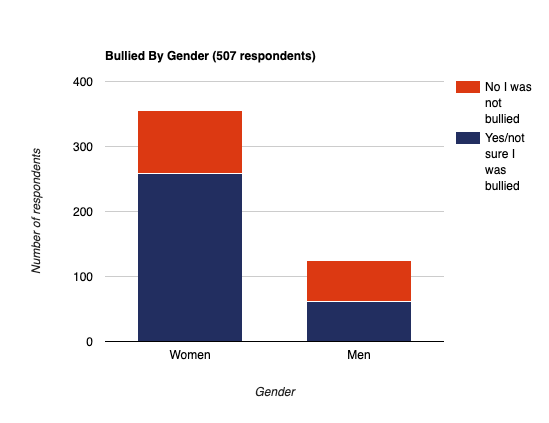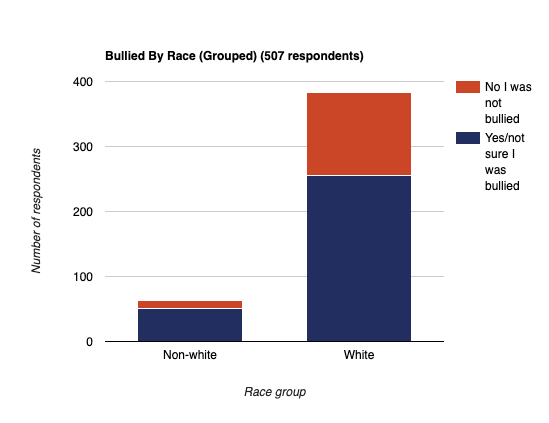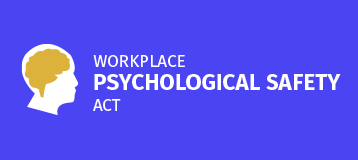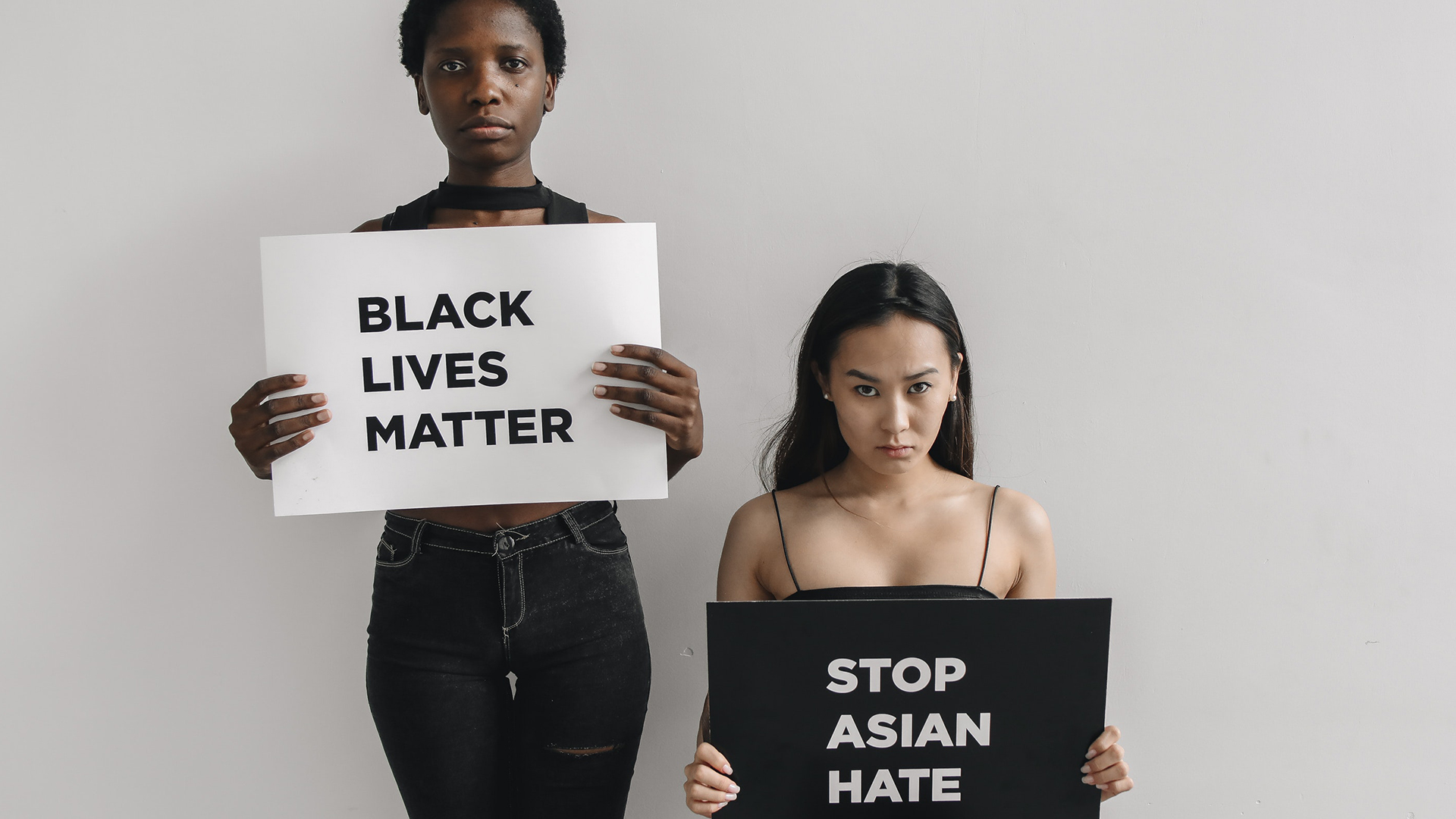Employers channel discrmination through bullying acts to keep those who threaten their power out of power.
At the heart of workplace psychological abuse is the imbalance and misuse of power, with people of color, women, members of the LGBTQ community, the oldest and youngest members of the workforce, those with disabilities, and other groups left out of norms mistreated more frequently.
The 2016 EEOC Select Task Force for the Study of Workplace Harassment Report clearly shows the discriminatory nature of worker mistreatment:
A 2021 Massachusetts survey of mostly state employees also shows a discriminatory impact of abuse at work on women and people color.


Headlines in the media
Anti-discrimination laws are supposed to protect workers against harassment and unfair treatment due to race, color, religion, gender, national origin, age (40 or older), disability, or genetic information, but they have failed to do so for decades based in part on courts’ requirement of proof of discriminatory intent rather than impact, what courts initially required when the law had teeth. Workers outside these protected classes have no legal protections whatsoever, yet the behaviors and damage are the same.
Those in power designed the rigged system to reinforce their power
Remind them who’s boss. Keep them on a tight leash. Win at all costs. Toxic employers expose their fear of losing control when they psychologically abuse competent workers who pose a threat to that control. That unchecked fear, entitlement, and lack of accountability embolden toxic bosses who try to protect their often unearned power and control.
Positive stereotypes around whiteness, manhood, heterosexuality, cisgender, middle age, and higher wages often equate with invulnerability (though many in these groups can also be bullied and mobbed), and many bosses and all employers have the power and privilege to:
- Control the narrative, including false accusations and sabotage, through closed-door conversations and subjective performance reviews to keep power over workers.
- Work without tight scrutiny from above.
- Speak up without fear of retaliation or minimization.
- See people of their gender, race, class, sexual orientation, and other privileged groups at the top and in the history of their organizations, normalizing their looking the part of leader.
- Be in the company of people of their same gender, race, class, sexual orientation, and other privileged groups most of the time and feel part of the in-crowd — even promoting them — rather than outnumbered, out-of-place, unheard, invisible, feared, or seen as a token hire.
- Minimize and ignore those not in the in-crowd, reinforcing their positions in the in-crowd.
- Use positive stereotypes to kiss up and negative stereotypes to kick down.
- Stand by white, patriarchal norms even if they are not white or men.
- Count on their identity to give their views more weight and respect and less questioning during meetings.
- Have a medical complication, a leave of absence, or a difficult span of time resulting in a lower performance without higher-ups attributing problems to their identity.
- Use doctors they pay to dismiss valid claims of workplace harm in others.
- Pay themselves high wages while paying their employees poverty wages, using them as welfare, to reinforce their power.
- Do well without being called a credit to some aspect of their identity.
- Never be asked to speak for all members of their identity groups.
We say this hierarchy sits against a backdrop of racism, sexism, classism, ableism, ageism, heteronormativity, and more ways of “othering” workers outside the norm — a ranking based on positive and negative stereotypes used to reinforce advantages and disadvantages. But when we put the agency back on perpetrators, we name these problems as actions based on white entitlement, male entitlement, toxic masculinity, and entitlement for those in the norm whose privilege remains invisible to everyone but those outside the norm. Those who:
- Wonder if their mistreatment is due to a performance issue or their skin color, accent, class, gender identity, ability, age, sexual orientation, religion, size, politics, or other difference.
- Hide part of who they are (socioeconomic class, sexual orientation, gender identity, religious beliefs, political beliefs, age, education, etc.) in fear of no longer belonging to the privileged group.
- See speaking up to HR or higher-ups as a dead-end route when they see that route not going well for their co-workers.
- Have to choose between their health and a paycheck when abuse of power makes them stressed and fearful.
- Know that even anti-discrimination law hasn’t disrupted the status quo and that if they go up against their employer, they’ll be one person against an army and a system. “The courts have moved in the direction of treating employment discrimination as a set of individual cases of intentional misbehavior, while the social science literature on discrimination increasingly points to a widespread, systemic character of bias in the organization of workplaces” (Berrey et al., 2017). If they do use the legal system to go up against discrimination, they also know their identity will also work against them with lawyers and in court, subjecting them to re-trauma, and that eventually the only justice they can seek is monetary, even if it only covers their legal bills. Employers rarely reinstate their jobs, hold bullies accountable, or change their work cultures, and case outcomes stay hidden for the employer but can jeopardize employees’ future job prospects.
- Internalize the oppression as trauma and insecurity and then feel blame and shame for struggling, less than, fearful, uncomfortable, and alienated.
Reporters often leave perpetrators — employers and bosses — out of rare headlines about workplace abuse, rendering these perpetrators invisible:
Imagine instead these reporters putting the agency on employers and bosses:
Kroger bosses allegedly drive worker to suicide; employer fails to address
Google allegedly fires Timnit Gebru for the same reason they hire her
Department of Corrections allegedly torments employee, who works with her ex-husband
This practice normalizes abuse of workers in a fear-based culture, keeping too many workers glorifying power, trying to prove we have what it takes to play the capitalist game, and stomping on each other to climb the ladder. Most of us unconsciously subscribe to this myth that equates and even romanticizes success with power and shame with lack of it.
Meanwhile:
- White men still retain power in the U.S. private sector workforce. Discrimination continues — at an unchanged rate since anti-discrimination law began in 1964. There are major earning disparities between racial and gender groups. In 2014, median incomes for Asian American and white men were nearly twice the median incomes for Latinx workers (Berrey et al., 2017):
| Group | Median Income |
|---|---|
| Asian American men | $59,766 |
| White men | $58,712 |
| Asian American women | $48,419 |
| White women | $44,236 |
| African American men | $41,167 |
| African American women | $35,212 |
| Latino men | $35,114 |
| Latina women | $30,289 |
- Workers are dying at staggering rates. We lose more workers each year — at least 4,000 — to preventable occupational injury, including psychological injury (Erin Duffin et al., 2022), than we did on 9/11 — 2,977 (Casualties of the September 11 attacks, 2022).
- It costs employers more to tolerate bullies than to let them go. Researcher Christine Porath said that “time wasted at work or spent searching for another job could cost companies up to $300 billion a year (more than the total net profit of the Fortune 500 companies)” (2016) — not to mention costs with turnover, lost opportunity, absenteeism, presenteeism, litigation, severances, settlements, workers’ compensation claims, and disability insurance claims. It’s been estimated workplace bullying and mobbing cost U.S. organizations anywhere from $180 million to $250 billion per year (Workplacebullying.org). As a point of comparison, the entire U.S. spend on TANF ($30 billion) and SNAP ($183 billion) doesn’t even total $250 billion per year.
- Employers pass staggering costs of not tending to employee well-being onto taxpayers through health care, TANF, food stamps/SNAP, housing, and heat costs, as our government and hospitals are left to deal with sick and uninsured former workers who can no longer afford basic living costs. “…the United States experiences about 59,000 excess deaths and about $63 billion in incremental costs annually compared to what would be predicted given its per capita income level. Considering the total toll previously estimated (of about 120,000 excess deaths and $180 billion in costs), our analyses indicate that about half of the deaths and about a third of the incremental costs from workplace conditions appear to be potentially preventable if the United States were more similar to other advanced industrialized economies,” according to Stanford professor Jeffrey Pfeffer in this book Dying For A Paycheck (2018).
Learn about America’s caste system »
A better way
It’s time to stop normalizing entitlement, which results in thousands of managers trying to prove their identity fits the part regardless of merit when they resort to childish abuse to boost their fragile egos and maintain their positions of power.
We often define strength for higher-ups and managers as controlling the most people with the most freedom with the ability to do the most damage.
This definition cheapens the real definition of strength: treating employees as humans with empathy, dignity, and respect; checking implicit bias and fear-based thoughts; and appreciating those who challenge the idea that working requires internal competition, kissing up, kicking down, joining in with toxicity, remaining silent, and boosting our own egos by psychologically abusing others.
These employees who challenge the toxicity of the majority of work environments welcome divergent thoughts and different ways of being. They include, improve, grow, and embrace change and difference in both their organizations and themselves.
It’s time to:
- Accept the days of lack of opportunity to get into positions of power, reinforced by systems, are still alive and well. These systems and the behaviors that support them influence whether people get jobs, advance, support themselves financially, achieve career goals, and contribute to generational wealth.
- Recognize the power and control narrative and the value we as a culture place on it.
- Acknowledge meritocracy and equality as myths and a system of privilege and oppression as our reality. This system rooted in ignorance and arrogance grants those in the norm permission to belong, dominate, hurt, neglect, and ignore others and the rest of us to assimilate, obey, and suffer.
- Be willing to see our invisible, normalized, unearned privilege around race, gender, age, ethnicity, ability, nationality, religious, or sexual orientation advantage.
- Stop simply disapproving of it. Become outraged about it enough to proactively give up power through anti-ism work so we can share power.
- Have conversations about privilege and invisible systems, even if they’re messy and uncomfortable.
- Take action by supporting legislation that will help prevent abuse at work, re-design the system, and distribute power rather than keep it in the hands of those who currently write the rules.
It’s time to end identity determining destiny and embrace inspiration, care, and connection — what’s feminized in our culture. It’s time for our employers, legislators, and legal system to protect employees from psychological abuse and prioritize well-being.
It’s time to fight against worker dehumanization, especially of those who aren’t part of the identity-based club.




